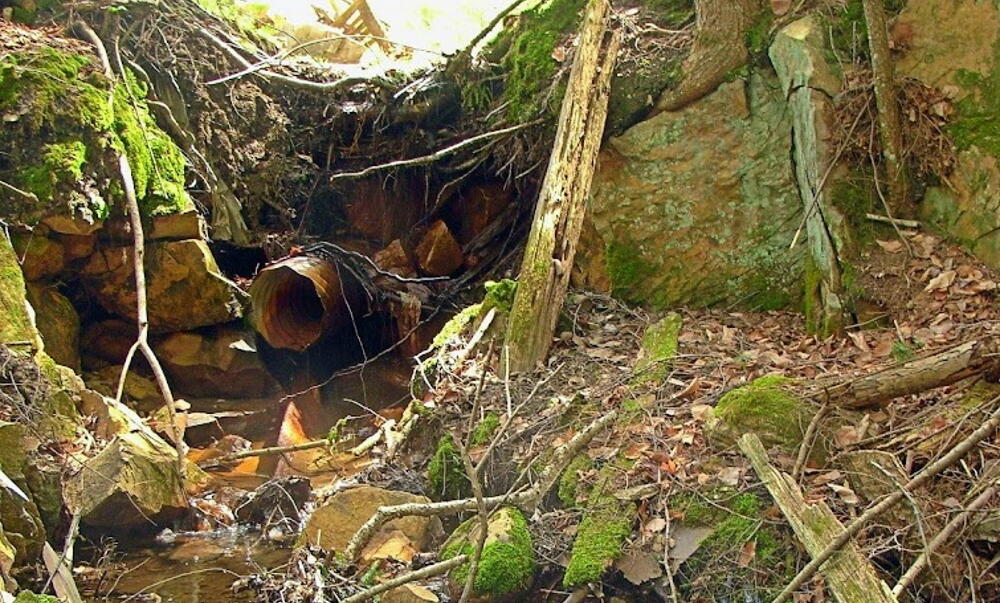Practice Description
Culverts affect all stream habitats in the state. While dams universally interrupt stream processes more completely, the number of improperly sized culverts and the general poor condition of the ageing infrastructure across the landscape creates many similar ecological impacts. The primary impacts to fish and wildlife resources include increased erosion and sedimentation, loss of sinuosity and habitat complexity, channel incision and interrupted connectivity. Existing culverts cause significant impacts if they exhibit a suite of characteristics: they are undersized, poorly designed, or have exceeded their design life and are not working properly. Sometimes all three characteristics exist at a given culvert. Undersized culverts result in high velocities passing through the structure and scouring at the downstream end. This results in “perched” culverts as the outlet sits perched inches to feet above the substrate downstream. This issue can be exacerbated by smooth-walled culverts (like plastic pipe) that further increase water velocities. Even pipes that are designed with the proper hydraulic capacity are typically perched in all but the lowest gradient streams. The scour, both up and downstream reduces the design life of the crossing by removing surrounding fill and causing eventual collapse. Failure of the culvert is one of the worst outcomes not only for road infrastructure and public safety, but for the stream biota as well. A single massive release of sediment and roadbed can bury mussel populations and kill and displace fish for years.
Goals and Ecological Processes
The goal of most culvert replacements or removals is to restore, or more closely approximate, natural stream conditions so that organisms, water, nutrients, and sediments can readily move throughout the watershed without causing excessive erosion and infrastructure failure. Climate change and associated alteration to hydrologic regimes will place increasing burden on existing structures that are not designed to accept the increased pulse flows expected in the future.
Target Habitats and Species
Due to the nature and history of infrastructure development in Massachusetts, all streams and rivers and many wetlands have been impacted by suboptimal or poor culvert design. Due to the long-term goal of restoring form and function through culvert replacement, all species associated with rivers and streams stand to benefit not only from the increased passage of aquatic organisms, but also from the restored sediment and energy transport. The benefit extends beyond fish species, which tend to make the most extensive migrations, to mussels, aquatic and semi-aquatic turtles, salamanders, aquatic invertebrates, and terrestrial organisms. Properly designed culverts will allow many of these animals to cross under infrastructure and will reduce mortality associated with vehicle strikes.
Associated Practices
- Dam Removal
- Floodplain Restoration
Methods
Practice Details
Culvert replacement or removal refers to the practice of either replacing a suboptimal culvert with an appropriately sized, designed and positioned culvert or, in some cases, decommissioning and removing the culvert entirely. Unlike dams that can last hundreds of years and can be expensive to remove, culverts are replaced more frequently as a matter of standard operation and public safety. The goal is to integrate passage for all animals that associate with water, from fish to mink to invertebrates, with those ongoing practices of repairing road/stream crossings and to provide public safety. Following the Stream Crossing Standards will help to accomplish multiple goals. Ideally, new structures will be wider than the existing channel, be located at the natural stream grade and have an open bottom lined with stream substrates. Project-specific designs will vary with site conditions.
Planning
Many culvert structures that meet the optimum condition for the stream crossing standards often come with additional planning considerations due to the increased size and footprint of the proposed culvert. Additional engineering, technical, education, regulatory, and financial planning considerations will likely need to be undertaken. In all cases, proponents will need to evaluate the crossing’s need, collect additional information, and develop an alternatives analysis which will be required for many environmental permits.
Engineering planning will need to include an assessment of road geometry and nearby property boundaries. Education and outreach will often be needed to illustrate the benefits of increased culvert size over and above ecological benefits (e.g., flood resilience). Additional regulatory planning can be necessary for FEMA and other purposes, but the biggest additional planning need will be financial as costs associated with culvert replacement will often be larger than replacing in-kind or with the minimum engineering standard. This increased cost can be partially or completely overcome in certain cases over the long-term. Some culverts with low up-front costs may have short design lives relative to a properly sized culvert. Also, additional funding sources are increasingly available in association with climate resilience and aquatic organism passage initiatives.
Return Intervals
All culverts have a design life that is associated with the materials used, the anticipated traffic burden and the installation method. Design life of 50 to 75 years is common in many circumstances. The primary benefit of using stream crossing standards and guidelines to replace existing culverts is that the structure is more likely to actually achieve or exceed that design life without being destroyed by environmental conditions like severe floods.
Examples
- Gulf Brook, Pepperell
- Sucker Brook, Pepperell
Additional Resources
Division of Ecological Restoration (DER) Culvert Replacements
